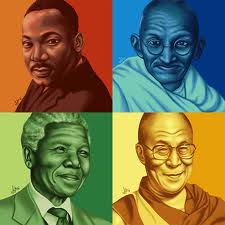Image: © www.morehouse.edu/Google
Much has been written on leadership in general. In this short blog, I express my views about authentic leadership and some of the characteristics they are likely to have in common.
The circle of influenceis much wider than the immediate position of a leader in an organisation. In fact an authentic leader may have a number of circles of influence. The ripples from these are felt strongly in and beyond their environment. These leaders are excellent at declaringtheir manifesto orstating their dream which they work tirelessly to bring to reality:
M K Gandhi was about ‘pursuit and practice of truth’. He believed in ‘truth in thought, truth in speech, and truth in action.’ His ‘satyagraha’ movement energised thousands of people in India and helped to achieve independence from Britain.
Martin Luther King had ‘a dream’ which he communicated powerfully during the Civil Rights movement in the US. It secured progress on civil rights in the US including legislation for equality for black Americans and other disadvantaged minority groups. Kings’s policy of non-violence influenced Black Conscious Movement and Anti- Apartheid Movement in South Africa.
Nelson Mandela fought for equality of all races in struggle for independence for South Africa and in ending Apartheid. With consultation from many groups who were committed to independence for South Africa, Nelson Mandala and his party, ANC, declared in their Freedom Charter that, “South Africa belongs to all who live in it, black and white, and that no government can justly to claim authority unless it is based on the will of the people.” Nelson Mandela was instrumental in achieving free elections in South Africa without violence when the country became independent in 1994.
The observer becomes the observed. The authentic leader has this ability, at least part of the time. To me, what it means is that in the dream or declaration of leaders do not experience distinction between the leader and the leadership, including leadership power. For example, M K Gandhi’s powerful message was condensed in his message “be the change you want to see in the world” and he practiced this in the struggle for independence for India and ‘awakening’ Indians to be ready for independence. When the Dalai Lama says, “If you want other people to be happy, practice compassion. If you want to be happy, practice compassion” ,compassion is happiness. The Dalai Lama certainly practices compassion, including towards the Chinese government which has occupied Tibet since 1960s.
Self-interest is non-existent or rank much lower in relation to personal needs. Authentic leaders have a sense of abundance in them. For example, Gandhi didn’t want a leadership role in independent India. He lived a simple life. His material needs were minimal. Although the Dalai Lama may be enlightened and may appear an icon for Buddhism and Buddhist way of life he is a simple person leading a simple life.
Other examples of authentic leaders include:
Mozart, Goethe, Einstein, Buddha, Jesus, Lao Tzu, Carl Jung, Sigmond Freud, Steve Jobs, Socretes and Mother Theresa. All these leaders had some of the characteristics discussed in this blog.
Are you an authentic leader? How large and strong are your ripples of influence?
Harish Davda, BA (Econ), MBA (Open) – Certified NLP Practitioner – Organisation Development coach and trainer. Author of an e-book ‘A useful guide to managing projects’ published by http://www.pansophix.com
Harish offers coaching on business development, personal transformation and authentic leadership to managers and business owners.
Tel: +44(0)7802485608
harish.davda@hotmail.co.uk © Harish Davda 2013


